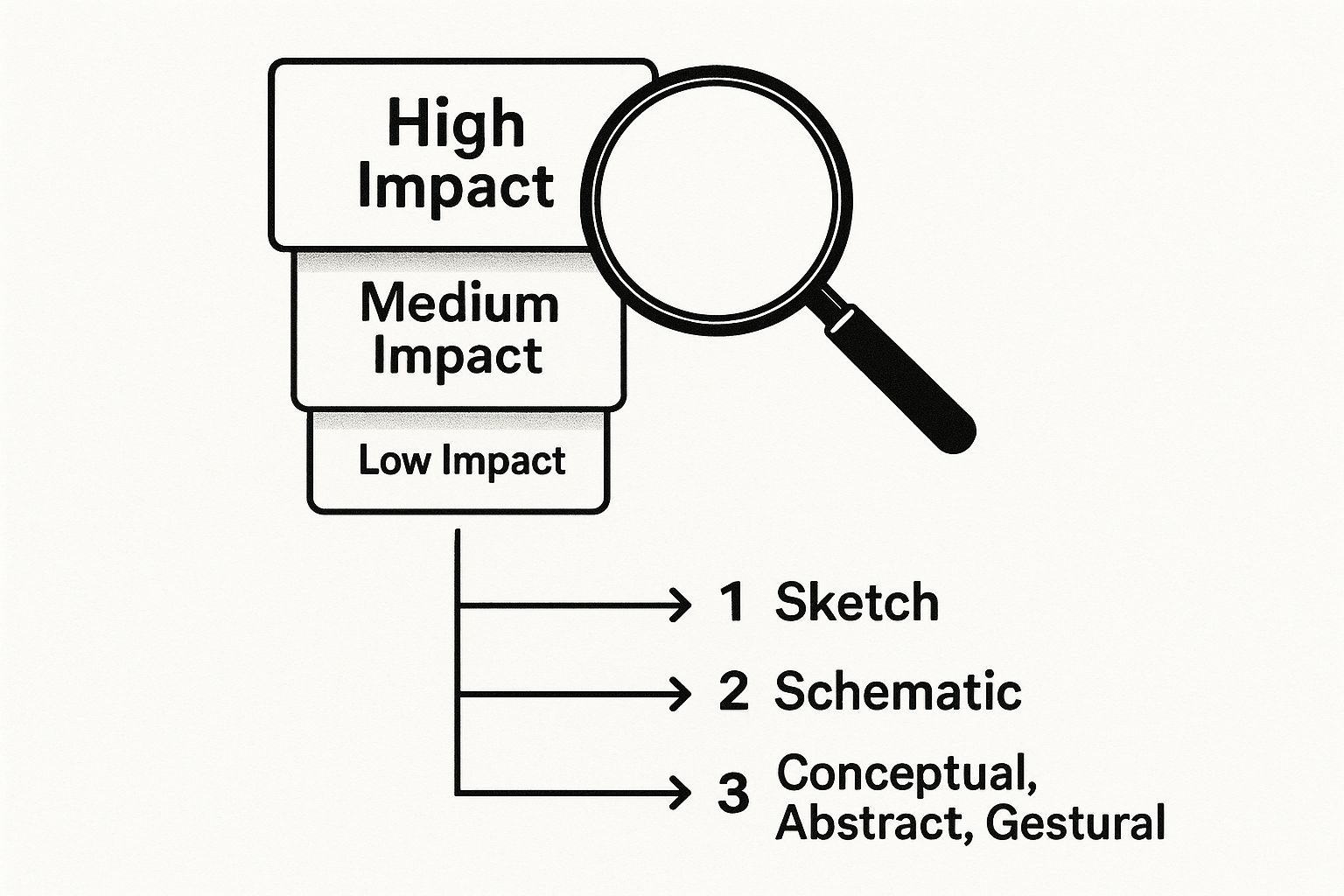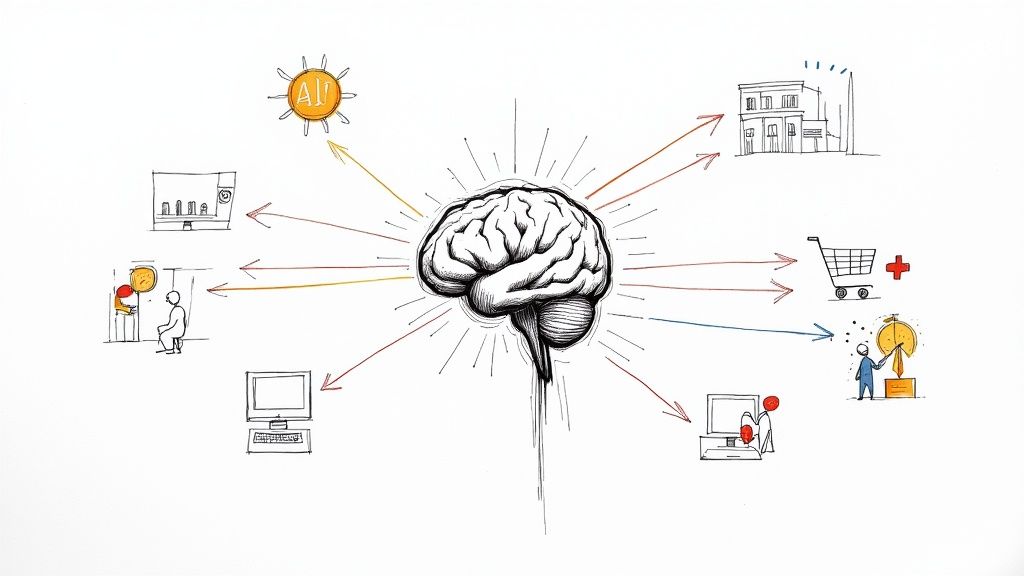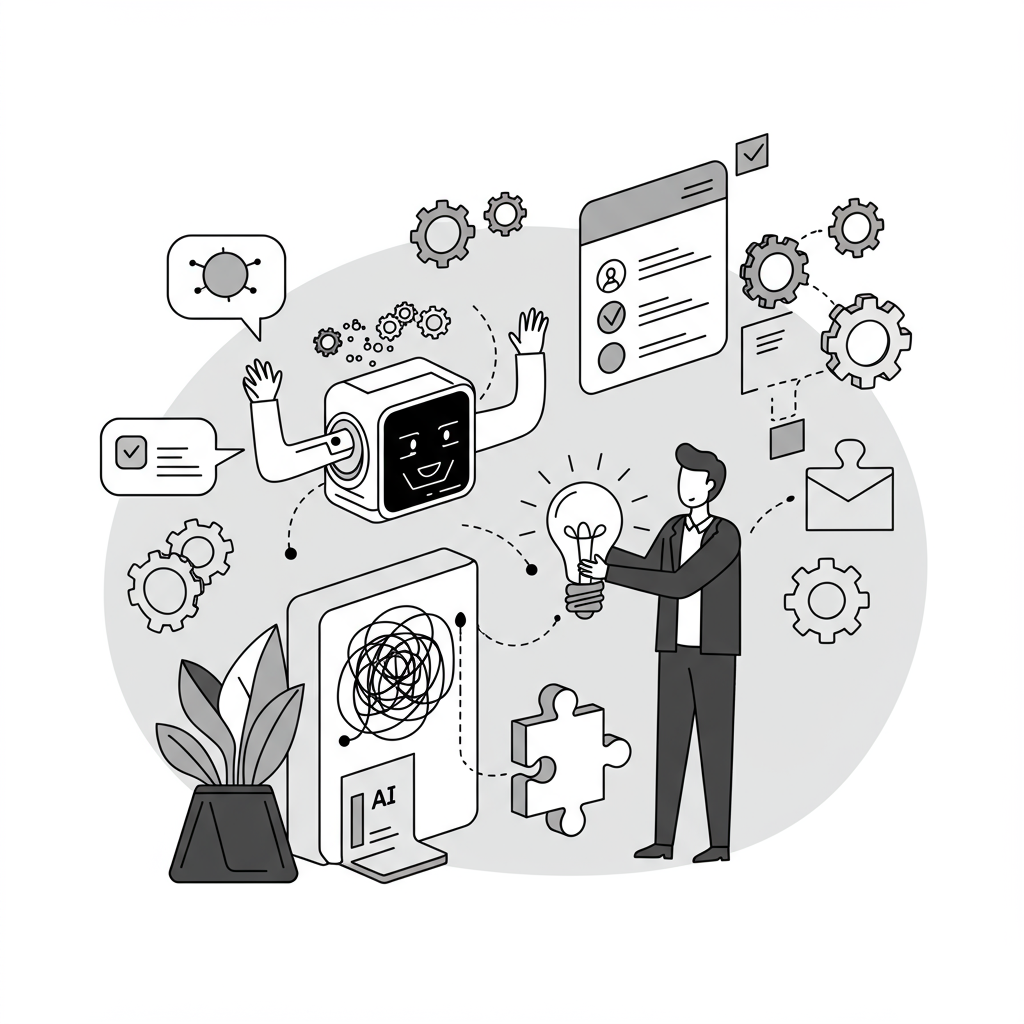Strategic AI Roadmap for Operational Efficiency: Boost Your Business
Create a strategic AI roadmap for operational efficiency with actionable steps to identify opportunities and drive growth. Start building your AI strategy today.

A strategic AI roadmap is more than just a plan; it’s your organisation's detailed guide to weaving artificial intelligence into the fabric of your operations. It’s about moving past random AI experiments and creating a structured path that connects your current capabilities to a future where AI drives real business value. Think of it as the difference between dabbling in technology and strategically embedding it to improve processes, cut costs, and boost productivity for the long haul. Without one, you're just hoping for a return on your investment; with one, you're planning for it.
Building Your Foundation for an AI-Powered Future
Before you can even think about launching sophisticated AI projects, you need to lay some serious groundwork. This foundational phase isn't about the flashy tech; it's about getting an honest, clear-eyed look at your organisation's current state. You have to ensure that every AI ambition is directly tied to a core business objective.
I've seen many companies get this wrong. They rush ahead, excited by the possibilities, but end up building on a shaky foundation. It's like building a skyscraper on sand—it simply won't hold up. The journey must start with a practical readiness assessment. This means rolling up your sleeves and identifying the business processes that are actually ready for AI. Look for the pain points: the repetitive tasks, the mind-numbing manual data entry, the bottlenecks that slow everyone down. These are your low-hanging fruit, the perfect places to score early wins and build momentum.
Shifting Focus from Costs to Long-Term Value

It’s easy to get fixated on short-term cost savings. While reducing expenses is certainly a benefit, a truly strategic approach looks at the bigger picture: long-term value creation. The real question is how AI can make you more efficient, yes, but also more innovative, agile, and competitive.
This mindset shift is what separates the leaders from the laggards. For instance, recent studies on AI adoption in Germany reveal a telling trend. While 35% of jobs there are influenced by AI, the most advanced companies are using it for far more than just trimming budgets. They're focused on strategic gains like product innovation and securing a competitive advantage.
Interestingly, the same research shows that while technical readiness is improving, only 18% of firms report high preparedness for managing AI risks and governance. This gap underscores the need for a balanced roadmap. For more on this, you can explore the findings on how AI regulation clarity is boosting preparedness.
A successful AI strategy doesn’t just ask, "How can we save money?" It asks, "How can we create new value?" This fundamental question should guide every decision in your roadmap.
Evaluating Your Organisational Readiness
To truly understand where you stand, you need to dig into three critical areas: your data, your technology, and your people. A brutally honest evaluation here is non-negotiable—it's the only way to know where your gaps are.
To help structure this process, you can use a simple framework. This isn't about ticking boxes; it's about starting meaningful conversations and getting a realistic snapshot of your capabilities.
AI Readiness Assessment Framework
Dimension | Key Evaluation Questions | Success Indicator |
|---|---|---|
Data Maturity | Is our data accessible, clean, and reliable? Do we have clear data governance policies in place? | High-quality, well-governed data is readily available for AI model training and deployment. |
Tech Infrastructure | Does our current tech stack (hardware, software, cloud) support AI workloads? Can it scale? | The infrastructure is flexible and scalable, capable of supporting AI pilots and full-scale rollouts. |
People & Culture | Does our team have the necessary data science skills? Is our culture open to change and new ways of working? | Teams are skilled and receptive to AI-driven changes, fostering a culture of collaboration and innovation. |
This assessment is your starting line. It provides the clarity needed to build a realistic and impactful roadmap.
Ultimately, this foundational stage is about fostering a spirit of AI co creation, where IT, operations, and business leaders work together towards a common goal. This collaborative energy is the secret ingredient for building a robust AI strategy framework that the entire organisation can get behind.
Finding and Prioritising High-Impact AI Opportunities
Once you've taken a hard look at your organisation's AI readiness, it’s time to get into the exciting part: hunting for specific opportunities. This isn't a free-for-all brainstorm for every cool AI idea out there. Instead, it’s a focused search for projects that will deliver a genuine, measurable leap in how your business runs. The real goal is to sift through all the possibilities and create a short, powerful list of high-value initiatives.
This whole process kicks off with a deep dive into your own operations. You need to map out your business processes—not just the official, on-paper versions, but how things actually get done every day. You're essentially an archaeologist, digging for the friction points: the bottlenecks, the stubborn inefficiencies, and the mind-numbing, repetitive tasks that eat up your team's precious time.
For instance, a logistics company might trace its entire order fulfilment journey. In doing so, they could discover that staff spend a few hours every single day manually matching invoices to purchase orders. That’s a classic, textbook case of a process just begging for AI-powered automation. It's this kind of granular investigation that uncovers the real gems that a high-level meeting would almost certainly miss.
From Ideas to a Prioritised List
With a healthy list of potential AI applications in hand, the next challenge is ranking them. Let's be honest, not all opportunities are created equal. A simple yet incredibly effective way to do this is with a scoring matrix, evaluating each idea against what truly matters to your business.
This structured method takes the guesswork out of the equation and makes sure your AI efforts are directly tied to core business objectives.
I always advise clients to build their matrix around three key pillars:
Potential Impact/ROI: How big of a difference will this actually make? Will it slash costs, boost efficiency, or improve quality in a meaningful way? You need a compelling return on investment.
Implementation Complexity: What are the real hurdles? Think about the data you have (or don't have), the technical skills needed, and how difficult it will be to integrate with your current systems.
Strategic Fit: How well does this project align with where the company is headed? Does it solve a burning problem for your customers or give you an edge over the competition?
Using Tools to Sharpen Your Focus
Defining the scope and requirements for every single project idea can feel like a mountain of work. This is where you can lean on modern tools to speed things up. For example, some teams find that an AI requirements analysis tool helps them quickly turn a business problem into a structured list of technical and functional needs.
This not only saves a ton of time but also creates a standard format, which makes comparing different projects a much fairer, apples-to-apples process. You move from evaluating a vague concept to a clearly defined project outline.
The objective is to distill a long list of ideas into a focused portfolio of high-value projects. This clarity is the bedrock of an actionable roadmap, turning abstract strategy into concrete steps.
To put this into practice, think of a financial services firm that has identified two potential projects: a sophisticated, AI-driven fraud detection system and a much simpler automated email sorter for the customer service team.
The fraud detection system scores very high on impact (preventing huge financial losses) and strategic fit (boosting security and trust). The catch? Its complexity is also extremely high, thanks to sensitive data and heavy regulations.
The email sorter, on the other hand, has a lower direct financial impact. But it's far less complex to get up and running and offers a quick win by freeing up customer service agents' time almost immediately.
By using their scoring matrix, the firm might decide to tackle the email sorter first. It's a perfect pilot project to build momentum and show results. At the same time, they can kick off the longer discovery phase for the more complex fraud detection system. This kind of phased approach, driven by clear prioritisation, is the hallmark of a mature strategic AI roadmap for operational efficiency. As you build out your plan, having a solid AI strategy framework is what will guide these tough trade-off decisions, ensuring your roadmap is both ambitious and achievable.
Crafting a Flexible, Phased AI Rollout Plan
If you’re building a strategic AI roadmap for operational efficiency, the biggest mistake you can make is carving it in stone. A rigid, all-at-once plan is a recipe for trouble. The most successful AI journeys I’ve seen are agile and iterative. This lets you deliver value fast, learn from what’s actually happening on the ground, and tweak your strategy as you go—all while keeping risk to a minimum.
The heart of this approach is phasing your implementation. Instead of trying to boil the ocean with a massive, company-wide overhaul, you break the roadmap into smaller, digestible stages. This isn’t about delaying results; it’s about swapping high-stakes gambles for smart, calculated progress. Using a dedicated AI Strategy consulting tool can be a real lifesaver here, helping keep all the moving parts of each phase organised.
Start with Pilots and Proofs of Concept
The best way to get the ball rolling is with small-scale pilot projects or Proofs of Concept (PoCs). Think of these as your real-world laboratories. They're designed to test your core assumptions, see if an AI solution truly has legs, and, crucially, demonstrate its value to any sceptical stakeholders.
A well-executed pilot project does a few things really well:
Checks Feasibility: It gives you a straight answer to the big question: "Can we actually pull this off with our current data, tech, and people?"
Builds Momentum: A quick win, no matter how small, gets people excited. It builds the confidence and buy-in you need for bigger, more ambitious projects down the line.
Offers Real-World Lessons: Pilots are goldmines for uncovering unexpected roadblocks and gathering the kind of practical insights you just can't get from a spreadsheet.
For instance, a manufacturing firm might kick off a PoC to predict equipment failure on just one production line. The goal isn't to fix the problem for the entire factory overnight. It's to prove that an AI model can accurately forecast maintenance needs on a small, controlled scale, delivering a clear ROI before you even think about a larger rollout.
Define What Success Looks Like for Each Phase
For every single stage of your roadmap—from the very first pilot to full-scale deployment—clarity is everything. You have to be incredibly precise about the scope, set a realistic timeline, and establish clear, measurable metrics for success. Fuzzy goals like "improve efficiency" just won't cut it.
You need to get specific. Let's say you're running a PoC for automated invoicing. Your metrics might look something like this:
Cut manual processing time by 50% within three months.
Slash the invoice error rate from 3% to less than 0.5%.
Hit a 90% user adoption rate among the finance team.
This level of detail turns each phase from a simple research project into a proper business initiative where everyone knows what they're accountable for. The image below shows a great way to think about prioritising these projects, focusing on high-impact initiatives first to get the best bang for your buck early on.

This visual really drives home the main idea of a phased approach: start where you can make the biggest difference quickly. This builds a rock-solid foundation for the entire roadmap.
Bring Together the Right Cross-Functional Team
Here’s a critical truth: implementing AI isn't an IT project. It’s a business transformation effort. Your success absolutely depends on putting together a cross-functional team that brings a mix of different skills and viewpoints to the table. This isn't just a nice-to-have; it's a must-have for navigating the complexities of weaving AI into your existing operations.
"A great strength lies in our extremely collaborative campus... It is this culture that allows us to leverage talent from all disciplines across campus to build multifaceted teams ready to tackle the biggest societal challenges."
This observation from academic research on collaboration gets to the heart of it. Your team needs to be a blend of:
Business Users: These are the people who will live with the AI solution every day. Their hands-on knowledge of the current pain points is priceless.
Data Scientists & AI Experts: The technical whizzes who will build, train, and deploy the AI models.
IT Professionals: The experts who make sure the new solution plays nicely and securely with all your existing systems.
This collaborative model, a form of AI co creation, ensures the final product isn't just a technical marvel but is also genuinely useful and perfectly aligned with what the business actually needs. It’s the key to bridging the gap between what's technically possible and what's operationally valuable—the very essence of effective AI strategy consulting. As we explored in our AI adoption guide, getting these groups talking early and often is vital for building understanding and driving adoption across the whole organisation.
Building Your Team’s Capabilities and Governance Model
Technology is only ever part of the solution. A truly effective strategic AI roadmap for operational efficiency depends entirely on your people and the rules you set for them. This is where we get into the human side of AI—nurturing the internal skills and building the solid governance needed to make any of this work in the real world.
Ultimately, long-term efficiency gains from AI aren't just about clever algorithms; they're about building a culture that understands and trusts the technology. This means committing to upskilling your workforce, structuring teams so they can actually collaborate, and creating an environment where people feel safe to innovate.
Cultivating an AI-Ready Workforce
You can't just hand people new AI tools and hope for the best. For this to stick, you have to intentionally upskill and reskill your employees. The aim isn't to make everyone a data scientist, but to establish a solid baseline of AI literacy across the entire company.
A good way to approach this is with training that’s specific to different roles:
For Leadership: Training should focus on the big picture—strategic thinking, risk management, and spotting high-value AI opportunities.
For Managers: They need the practical skills to lead AI projects, manage teams working alongside AI, and adapt their day-to-day operational processes.
For Frontline Employees: This is all about hands-on training for the specific tools they’ll be using, with a heavy emphasis on how AI makes their jobs better, not redundant.
When you tailor the training like this, everyone understands where they fit into the picture. It helps dial down the fear and gets people genuinely on board from the start.
Structuring Teams for AI Success
Old-school departmental silos will kill an AI project before it even gets going. AI thrives on cross-functional teamwork, so your team structure needs to reflect that. You need to bring different types of expertise together to crack complex problems.
I've seen the "hub-and-spoke" model work incredibly well. You have a central AI team (the hub) that holds the deep technical expertise, sets standards, and builds core platforms. This hub then supports the different business units (the spokes), who own and run their own AI initiatives. It’s a great way to balance strong, centralised governance with the freedom for individual teams to get things done.
One of the biggest mistakes I see is companies treating AI as just another IT project. Real operational efficiency happens when your business experts, data scientists, and IT pros are in it together as equal partners from day one.
Data from Western Europe, including Germany, really drives this point home. Research has shown that generative AI could boost annual productivity growth in Europe by as much as 3% through 2030. The catch? There's a massive gap between investment and actual capability. Western Europe's AI spending is currently lagging 70% behind the US, which contributes to a performance gap of 45-55% in key industries. These numbers show just how urgent it is for companies in the DE region to build a focused roadmap. Learn more about Europe's AI opportunity and the path forward.
Establishing a Robust AI Governance Model
Powerful tools demand clear rules. Think of your AI governance model as the non-negotiable rulebook for using AI safely and ethically. It's what gives your teams the confidence to experiment without taking unnecessary risks. This framework needs to spell out your policies in a few critical areas:
Data Privacy and Security: Have strict protocols for how data is handled—from collection to storage and use—to stay compliant with regulations like GDPR.
Ethical Guidelines: Create a clear set of principles to tackle potential bias in your AI models, ensure fairness, and be transparent about how decisions are made.
Regulatory Compliance: The legal side of AI, like the EU AI Act, is always changing. You need to constantly monitor it to ensure your applications are compliant.
Accountability and Oversight: Define who owns what. Who is responsible for an AI model’s performance? Who has the authority to step in if something goes wrong?
Without clear governance, you’re opening yourself up to reputational damage, legal trouble, and a complete loss of trust from customers and employees. This isn't an afterthought; it’s a foundational step. For more complex projects, partnering with our expert team can give you the specialised guidance to build a governance model that is both solid and genuinely practical for your business.
Measuring Success and Refining Your Strategy

Here's a hard truth: your strategic AI roadmap for operational efficiency isn't a "set it and forget it" document. If you just file it away after a kick-off meeting, it's already obsolete. Think of it as a living, breathing guide that has to evolve with new data, shifting business priorities, and the relentless pace of technology.
This final part of the process is all about creating a continuous loop of measurement, learning, and refinement. It’s how you make your strategy smarter over time, ensuring your investment pays real dividends far beyond just trimming the budget.
Defining What Success Actually Looks Like
To get this right, we need to move past a one-dimensional focus on cost savings. Yes, that’s important, but it’s only a fraction of the story. To truly grasp the impact of your AI initiatives, you need to define a rich set of Key Performance Indicators (KPIs) that paint the whole picture.
I always recommend organising KPIs into a few core categories to get a balanced view.
Operational Efficiency: This is your ground zero. Track direct metrics like process cycle time, the number of tasks automated per week, or the reduction in manual errors. If you’ve automated invoicing, for example, the core KPI is simple: how much did you shrink the time from invoice receipt to payment?
Productivity Gains: This is about output. Are your teams achieving more with the same resources? Here, you’d look at things like cases resolved per agent, reports generated per hour, or a tangible increase in production throughput.
Quality Improvements: AI is brilliant at boosting consistency. Measure this with improvements in customer satisfaction (CSAT) scores, a reduction in product defects, or better data accuracy rates.
Employee Experience: Never, ever forget the human element. AI should be a tool that frees your team from drudgery, not one that adds new frustrations. Keep an eye on employee satisfaction scores related to new AI tools and, crucially, track the time reallocated to high-value strategic work.
This balanced scorecard approach ensures you’re not just making processes cheaper, but genuinely better for the business and your people.
Creating Robust Feedback Loops
The numbers from your KPIs are critical, but they only tell you what is happening. They don't tell you why. For that, you need to talk to the people on the ground—the ones using these new AI tools every single day.
Setting up effective feedback loops is the key. These don't need to be complex; they just need to be consistent. You could use:
Regular, short user surveys
A dedicated channel in Slack or Teams for AI feedback
Informal check-in sessions with teams who have adopted a new solution
The goal is to understand the context behind the data. Why is one department struggling with adoption? What unexpected benefits are people discovering?
A great KPI tells you what happened. A great feedback loop tells you why it happened. You absolutely need both to refine your strategy effectively.
This mix of quantitative data and qualitative insight is what allows you to make smart, nuanced decisions instead of just reacting to numbers on a dashboard.
The Cycle of Review and Refinement
With your metrics and feedback channels established, you can build a regular rhythm for reviewing and refining your roadmap. This isn't a single, stressful annual review; it's a continuous cycle of improvement.
Typically, this looks like a quarterly or biannual roadmap review where your team gets together to:
Assess Progress: Go through the KPIs for every active AI project. What's working? What isn't?
Re-prioritise Initiatives: Based on the results and any new business needs, adjust the pipeline. A pilot that delivered shocking ROI might get fast-tracked, while another gets paused for a rethink.
Incorporate New Learnings: Use the qualitative feedback to spot common challenges or opportunities you hadn't considered.
Scan for New Technology: The AI field moves at a blistering pace. Make time to evaluate if new tools or techniques could solve your problems better than what you chose six months ago.
This iterative approach is what keeps your roadmap relevant and powerful. It can also be helpful to look at trends in similar markets for direction. For instance, recent data from the Netherlands shows a huge jump in AI adoption, with 22.7% of companies now using it. That figure leaps to 67.6% for large enterprises. Their focus? Boosting operational efficiency. Given Germany's comparable economic landscape, these trends make a strong case for accelerating your own strategic AI roadmap for operational efficiency. You can find more on this in reports exploring how AI can give the Dutch labour market a productivity boost.
Navigating this continuous cycle can feel overwhelming, especially for complex projects. If you need help interpreting results and adapting your strategy for a lasting competitive edge, working with our expert team can provide the specialised guidance to keep you on track.
Common Questions About AI Roadmaps
Even with a detailed guide, I know that kicking off a strategic AI roadmap for operational efficiency can feel a bit daunting. It’s natural to have questions. Over the years, I've heard a few common ones pop up from business leaders just starting this journey, so let’s tackle them head-on.
How Do We Get Executive Buy-in for a Long-Term AI Roadmap?
This is often the first, and biggest, hurdle. The trick is to stop talking about technology and start talking about business value. Your executive team thinks in terms of ROI, market share, and cost savings, so you need to frame the AI roadmap in their language.
Use the data from your readiness assessment to build a compelling business case. Show them the numbers—projected ROI, a clear-eyed risk analysis, and a realistic timeline for returns. Don't try to sell a massive, five-year monolith. Instead, propose a phased approach starting with pilot projects that promise quick, measurable wins. These early successes create momentum and make it infinitely easier to get approval for the bigger, more ambitious projects down the line. Backing up your pitch with compelling, industry-specific real-world use cases can really help seal the deal.
What Is the Biggest Mistake Companies Make When Creating an AI Roadmap?
Without a doubt, the single biggest mistake I see is an obsessive focus on the technology while completely neglecting the people and processes needed to make it work. So many organisations get dazzled by the latest AI tool, but they fail to train their teams, adapt their workflows, or set up clear governance.
This oversight leads to two predictable outcomes: expensive pilot projects that go nowhere or sophisticated tools that gather digital dust. A solid AI strategy framework has to be a three-legged stool, giving equal weight to technology, people, and process. This isn't just an IT project; it requires genuine AI co creation between your tech specialists and your business units from day one.
A roadmap that only lists technologies isn't a strategy; it's a shopping list. A real strategy weaves technology into the fabric of how your people work and how your business runs.
How Long Does It Take to See Real Results from an AI Roadmap?
The timeline always varies, but a smartly designed, phased roadmap should deliver its first tangible results within 6 to 9 months. The key is to start by targeting the "low-hanging fruit"—those high-impact projects that aren't overly complex to implement.
Think about automating a specific, mind-numbing back-office task. Nailing these early wins is crucial for proving the concept and silencing the sceptics. Of course, the more transformative results, like re-engineering a core business function around AI, will take longer. You're probably looking at 18 to 24 months or more for those to fully mature.
Should We Build Our Own AI Solutions or Buy Off-the-Shelf Products?
Ah, the classic "build vs. buy" debate. There’s no single right answer here; it truly depends on the specific problem you're trying to solve. You have to evaluate it on a case-by-case basis.
Buy: For common business problems like customer service chatbots or basic document analysis, buying a ready-made solution is almost always faster, more reliable, and more cost-effective.
Build: If you're tackling a process that is completely unique to your business—something that gives you a competitive edge—then a custom-built solution might be the only path forward.
Hybrid: More often than not, a hybrid approach works best. You can license a vendor's platform for the foundational AI capabilities and then task your in-house team with building the proprietary models that sit on top.
This is a major strategic decision. An AI Strategy consulting tool can help you map your needs to potential solutions, and for more complex scenarios, talking it through with our expert team can provide the clarity you need to make the right call.
If you have more questions buzzing around, we've put together some more detailed answers—you can explore our FAQ page for more insights.
Ready to turn your AI ambitions into a concrete plan for operational efficiency? Ekipa delivers a tailored strategic AI roadmap in just 24 hours. Move from ideas to impact, faster. Our expert team is ready to help you succeed. Discover your AI opportunities today.



